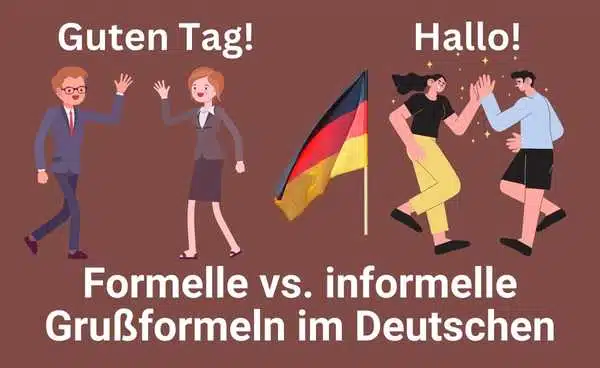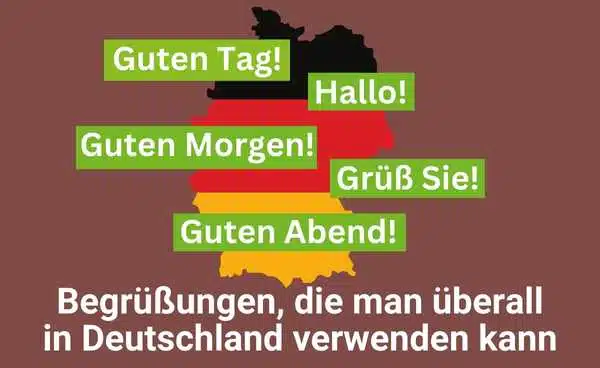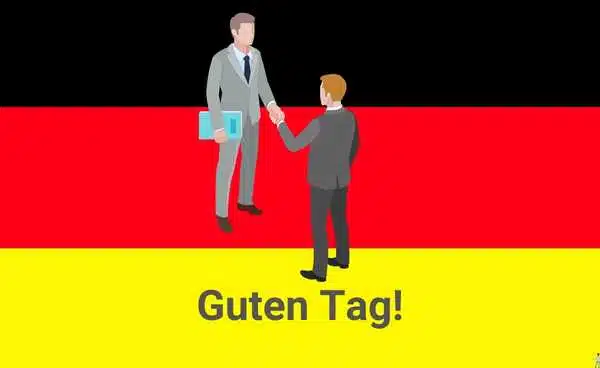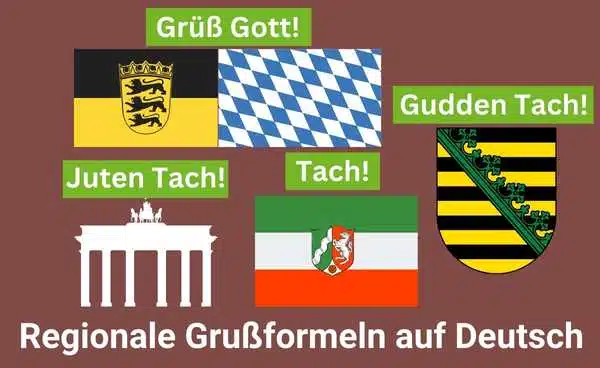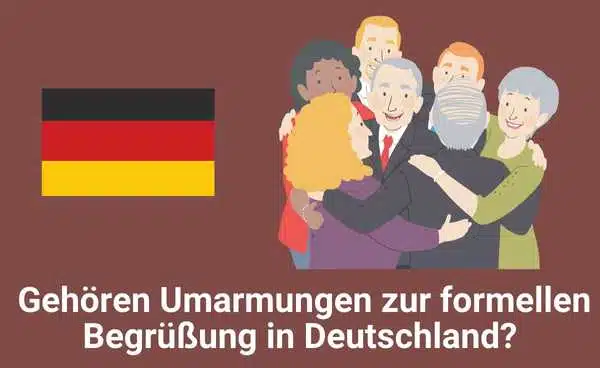Formal greetings in German are an important part at the beginning of nearly every conversation. To help you understand the etiquette, I will provide you with my learnings and my own experience. I experienced many different situations during all those years living and working in Germany.
Key takeaways
- Formal salutations are an important element of your day-to-day business communication in Germany.
- This article will teach you the major differences between formal and informal greetings.
- Also, I will provide you with the most common formal greetings to be used everywhere in the country.
- Furthermore, this article offers some regional phrases.
- Communication in a business environment via email is another crucial part.
- Lastly, you will learn more about etiquette during greetings with a formal character.
Topics in this article
Formal vs. informal greetings >>
Common phrases for formal greetings >>
Regional phrases for formal greetings >>
Business greetings in Germany >>
Polite greetings in German in email >>
Handshakes and formal greetings >>
Hugs and formal greetings etiquette >>
Formal greetings and kisses >>
Eye contact during formal greetings >>
The difference between formal greetings and informal greetings
Yes, there is a difference between formal and informal salutation expressions in German. While the informal ones can be short and sweet, the formal ones are a bit more complicated. On the other hand, informal greetings are used mainly when you meet in an informal setting or with friends and people you know.
Let me dive deeper into some examples based on different situations I experienced over the years.
Most common phrases you can use everywhere in Germany
- “Guten Tag” literally meaning “good day” in German, is commonly used everywhere as a formal greeting
- “Guten Morgen” is used only during morning hours
- “Guten Abend” is also considered to be a very formal version during evenings
- “Hallo”, the equivalent for “hello” is less formal but can still be used
- “Guten Tag! Wie geht es Ihnen?“ It is often used as a formal greeting plus the question, “how are you doing?”
- „Guten Tag, Herr/Frau (put in the last name)“ can be used if you know the last name of your acquaintance
- “Grüß Sie” can also be used in a little less formal setting, also in combination with the last name to say hello
- “Grüß Sie, Herr/Frau (put in the last name)“ would be the extended version of the one mentioned above
Regional phrases for formal greetings in the German language in Germany and Austria
There are regional phrases in Germany used during formal greetings. There is also a difference between Germany and Austria. So let me give you some examples based on my own experience.
Germany
- “Grüß Gott” is similar to “Guten Tag” in the southern parts of Germany. Especially in Bavaria, where I live, and Baden Wuerttemberg
- “Juten Tach” a localized version of “Guten Tag” for the Berlin area, is commonly used
- “Gudden Tach” or “Gun Tach” can be used in Saxony
- “Tach” as a short version is used in North rhine Westphalia
Austria
- “Grüß Gott” or using “Guten Tag” is commonly used throughout the country as a formal greeting
Are business greetings in Germany different than in other countries?
After arriving in Germany and attending my first business meetings with the company I am working for, a couple of things stood out.
- Germans offer a brief and firm handshake as a greeting.
- Usually, they also say “Guten Tag” (a formal version of saying hello).
- If people know each other already, saying just “Hallo” (the informal greeting in German to say hello) is also appropriate.
- In the southern parts of Germany where I live, people also like to say “Grüß Gott” (a formal version to say hello, for example, in Bavaria and Baden Wuerttemberg).
- When saying goodbye or “Auf Wiedersehen” after a business meeting in Germany, it’s common to have a quick handshake.
In the video below you can learn how to use the German greetings in meetings. Learn more about this topic here.
Here is some general information about business greetings in German:
You should make sure to greet women first. If you know more about the hierarchy of the people attending, things may get a bit more complicated. Greet the highest person in charge first, women first, men second.
Being polite also means being punctual and standing up for a greeting. In business meetings, you should always follow those rules.
A French colleague once explained that it’s common to kiss each other on the cheeks three times when seeing each other. It does not matter whether you are meeting a man or a woman; it’s cultural. A US colleague told me he wasn’t used to standing up when someone entered the room.
As you can see, there are some differences, so be mindful of business greetings in Germany.
Are formal greetings in email different than in spoken language?
Formal greetings in a German email are slightly different, depending on the situation. The easiest way to understand formal business German was to think about it as if I was writing a letter.
In the following, I am distinguishing between two different scenarios. First, I will tell you how to address a single person in an email. Second I will tell you how to address a group of different people in an email.
Formal greetings for emails with one recipient
- “Sehr geehrter Herr (put in his last name),” for male recipients and
“Sehr geehrte Frau (put in her last name),” are both used in a very formal setting.
This applies when you don’t know the person very well or not at all. If you get to know the person better, you may switch to one of the following examples. - “Hallo Herr (put in his last name),” or
“Hallo Frau (put in her last name),”.
These are less formal than the first example.
Formal greetings for emails with more than one recipient
If you are in a situation where you have to address two recipients, I recommend using the following formula:
- “Sehr geehrte Frau (use her last name), sehr geehrter Herr (use his last name),”
This formal German greeting covers two things: First, you are respecting the general rule that it’s best to address women first and second, it’s the most formal greeting you can use for two recipients.
When I was about to send my first email to three people, my colleagues told me to use better the following phrase instead of addressing all of them personally.
- “Sehr geehrte Damen und Herren,”
It is the most formal greeting in German in an email that you can always use for groups. Just in case you do have women on the list of recipients. In English, the equivalent would be “dear Sir or Madam”. If there are either only men or only women, please use the following: - “Sehr geehrte Herren,” or
“Sehr geehrte Damen,”
From my experience, both versions are very often not used.
Handshakes and proper greeting expressions in German
Handshakes are especially common when it comes to salutations. At the beginning of business meetings with a client, you usually shake everybody’s right hand.
Even outside a business setting, it can be appropriate to shake hands. I learned from the first months of living in Germany that it can be good to watch for signs of the other person. For example, when I introduced myself to my neighbors, they all shook my hand.
Be aware that this behavior changes over time when you get to know someone better. You can say, the less formal it gets, the less likely Germans will shake hands with you.
Do hugs belong to formal greetings etiquette in Germany?
Depending on your cultural background, formal welcome phrases might be a mystery for you. When I arrived, I started watching other people’s behavior. Soon, I realized a vast difference between informal and formal greetings.
The formal greetings etiquette, as mentioned above, does include a handshake at the beginning and the end of a meeting. Hugs do usually not belong to it.
But I experienced while attending meetings with other colleagues and clients at work that some of them hug each other. So I asked my colleague afterward why they hugged each other. He said this was, on the one hand, because they had known each other for a few years and on the other hand. After all, they haven’t met for a while.
Formal greetings and kisses in Germany
It’s the same with kisses. When I was on vacation with my family in France, we saw that the French culture was entirely different. They seem to give each other kisses even in a professional setting. Germans don’t do that.
Never in those years I have been living and working in Germany did I experience someone kissing each other on the cheeks during a formal greeting. And even in a less formal situation, it hardly happens except if people have been friends for many years.
Do I have to maintain eye contact?
Maintaining eye contact is a must. It’s considered polite. Germans are, in general, very direct communicators from what I experienced. I learned from German friends that maintaining eye contact is essential when discussing serious matters.
Eye contact is also a sign of confidence. Breaking eye contact is appropriate now and then during a conversation. Staring is something that can make people uncomfortable. When talking to groups, you should make sure to make eye contact with all people.
Conclusion
I hope I was able to provide you with a lot of real-life examples coming from my professional experience. Give yourself time to learn the etiquette and formulas used to address someone adequately during a meeting and in emails.
Following the formal greetings in German, I provided here will come in handy in every business situation you can think of.
USEFUL INFORMATION ABOUT LEARNING GERMAN
> Learn How to Write an Email in German
> Top 10 German Language Level Test Tools Online Today
> German Language Levels Explained
> Is it hard to learn German? No, if you follow these simple tips
> What level of German is required to work in Germany today?
> 6 tips on How to Learn German A1 at home gets Super EASY
> 10 Ways To Learn Business German Fast
> Checked: How to get B2 Level in German at Goethe Institut
> Effective Online Courses For German Language
* The links that are marked in this way are affiliate links and indicate that we receive a small commission if you decide to buy the products or services offered by our partner sites. But for you, it won’t cost anything extra.


